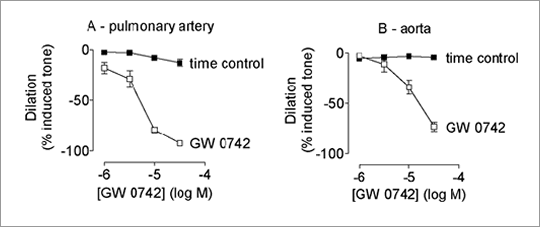022P Brighton
Winter Meeting December 2007 |
Acute vasodilator effects of PPAR-beta agonists in mouse pulmonary artery and aorta
Anna Reed1, Louise Harrington1, Laura Moreno1, Timothy Warner2, Steven J. Wort3, Jane A. Mitchell1
1NHLI. Imperial College, London, United Kingdom, 2The William Harvey Research Institute, Barts and the London, Queen Mary’s School of Medicine and Dentistry, London, United Kingdom, 3Royal Brompton Hospital, London, United Kingdom
Pulmonary hypertension is a life threatening disease characterised pathologically by pulmonary arterial vasoconstriction, vascular remodelling and intraluminal thrombosis. Treatments such as prostacyclin are aimed primarily at reversing vasoconstriction and increasing blood flow within the pulmonary circulation. However, prostacyclin therapy is limited because it requires intravenous administration and can cause systemic hypotension. Prostacyclin is sensed by two receptor pathways, cell surface IP receptors and cytosolic PPAR nuclear receptors. Recent evidence from our group suggests that some of the effects of prostacyclin in the lung are mediated by activation of PPAR-beta. Moreover, we have shown that PPAR-beta is active in platelets where it mediates acute, non-genomic inhibitory effects. However, the potential for PPAR-beta agonists to similarly effect vascular tissue has not been addressed. Here we have investigated the abilities of a PPAR-beta agonist to dilate pulmonary arteries and aortae from mice. Six to eight week old C57B16 (WT) black male mice weighing 20-30 g were killed by cervical dislocation. The aorta and first order pulmonary arteries were removed, mounted in wire myographs and normalised as described previously (Moreno et al., 2006). Vessels were then contracted with an EC80 concentration of U46619 (3x10-8M). Once stable contractions were attained, cumulative addition of the PPAR-beta agonist GW0742 (10-6-3x10-5M) caused vasodilatations, with greater potency (p<0.02) on pulmonary arteries (log EC50; −5.2±0.1; n=8) than aortae (log EC50; −4.4±0.3; n=6) (Figure 1).

Figure 1. Effect of GW0742 on pulmonary artery (A) and aorta (B).
Here we show that a PPAR-beta agonist more potently dilates pulmonary arteries than aortae. We also show, for the first time, that a PPAR-beta agonist can cause immediate effects in vascular tissues independent of gene regulation. These findings suggest that PPAR-beta agonists, which are orally active, may be an effective treatment for pulmonary hypertension with reduced side effects
Moreno L., et al. (2006). Respir Res, 7, 111
|